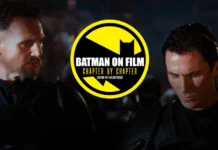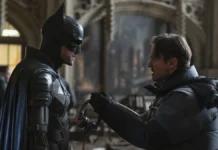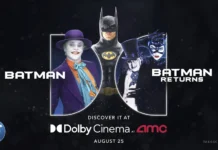Interview Conducted by Paul J. Wares in 2009
Hello BOF’ers — long time, no talk! It seems fitting that in the year of the 20th Anniversary of BATMAN (1989) — and right after Halloween mind you — I should examine the suit that kids everywhere wanted to have in October of 1989. I’ll admit, I did too. Thankfully I’ve destroyed all photographic evidence of my pathetic attempt to replicate movie magic.
As many readers of this site will know, I’m a huge fan of the first Batman movie, or as it’s become affectionately known over recent years as “B89.” I detailed much of what I love about B89 in my “BATMAN ‘89 Retrospective “ but the thing that first got me hooked on this film and anticipate it like no other was the very first picture of Batman that I saw and the costume he was adorned in.
Gone were the tights. Gone were the underpants over them. Gone was the blue and grey. In its place was a black, armored creature of the night and I would never look at Batman the same way again.
Keaton looked menacing and intimidating not to mention downright cool! We of course had Tim Burton, Anton Furst, and Bob Ringwood to thank for that, but that is only the tip of the iceberg.
When speaking to Day Murch during BOF’s BATMAN BEGINS set visit in 2004, he told me; “If I’m ever asked to describe my job, I always explain that I represent all the talents that have worked on the suits and there are a lot of disciplines represented here. I rather like to think that I represent the family that worked on the suit going right back to the first movie. We don’t make this suit substantially in any different way than the way the other ones were made we just make it better because we’ve had longer to get it right. I’m just part of a chain that links back to Vin Burnham who made the first suit and Bob Ringwood who designed it and I don’t think any of us would deny we owe an enormous amount to those people”.
As they say on the internet “Quoted For Truth.”
Over the past few years, I’ve studied and researched the ‘89 suit extensively — in fact it’s become quite a hobby of mine. During this quest for information, I began to discover what an enormous undertaking this suit was, how it broke the mold (and perceptions) of what a superhero costume was, and what an amazing technical achievement it was for its time.
It seemed appropriate then, during B89’s 20th Anniversary year that I revisited the making of this groundbreaking costume and talk to someone that knew about the hard work, craftsmanship, and artistry that was poured into it.
That being the case, there was only one person that I wanted to talk to and her name was Vin Burnham.
Vin’s career spans more than three decades working with industry greats, such as Bob Ringwood, James Acheson, Jim Henson, and Nick Dudman. She is also a costume designer in her own right with a wealth of movie and television credits to her name.
Most importantly, to the Batman fan community, she had the perhaps unenviable task of bringing a two-dimensional comic book character to life in three dimensions and introducing the world to the first blockbuster movie Batman.
In doing so, Vin created a costume that would define the character on the silver screen for two decades and beyond. I was fortunate enough to recently interview Vin about her work on BATMAN and BATMAN RETURNS.
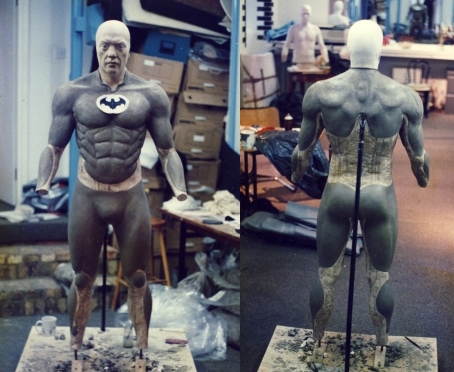
Vin Burnham: In 1988 I had a call from Bob Ringwood asking if I’d like to make a costume for a new film version of Batman. It didn’t grab me at all. I thought it was boy’s stuff, so I suggested someone else (a boy!). But Bob wouldn’t take no for an answer. I was known at the time for having done Aslan the Lion for the BBC’s CHRONICLES OF NARNIA, and I was interested in the sculptural aspects of such work. Bob convinced me that we’d sculpt the Batman costume and that he also wanted it to be animalistic.
So I agreed to make a mock-up head in clay to show new director Tim Burton who was coming to London.
These was fairly early days in lifecasting and prosthetic make up techniques, and the Actor cast as Batman, Michael Keaton was in LA and not available to us, so sculptor Eddie Butler was commissioned to sculpt a portrait of Michael Keaton’s head, and it was over this that I sculpted the tryout Batman cowl.
PJW: What inspiration/reference material did you use for this first sculpt?
VB: As well as Bob’s designs, really the comic book illustrations were the main reference, though I don’t remember which artist or period it was, but it was one with long blade-like ears. I also loved the stylized Burne Hogarth anatomical drawings for reference, more dynamic than Grey’s Anatomy. Bob and I also studied his dog, a bull terrier called Rose. I always thought that those dogs looked like Bugatti’s, and Rose’s clean rather aerodynamic lines had a direct influence on the suit.
It was never intended (the first sculpture) to be the final head, so I wasn’t agonizing over it the way I might do on a sculpt that I knew would be going in front of the camera. It was really more of a sketch. It worked instantly and looked powerful. Tim Burton was sold on the sculptural approach. We would make it like a costume version of prosthetic makeup, and apply foam pieces to a form-fitting suit.
PJW: Did you meet with Tim Burton during this stage? What were your first impressions of him?
VB: Yes absolutely. Tim came to my studio at Olympia to see the prototype sculpt, this was the first time I met him and I liked him immediately, he was so passionate about the project, very approachable, and open to discussion. Being an artist himself, he responded to the sculpt with an artist’s eye. He was very hands-on, and was always sketching, even when he was on the phone he’d be doodling. His drawings were packed with atmosphere, it was a great way of communicating. On BATMAN RETURNS, he even did a mock-up of Catwoman’s head with paper ears stuck on – it said it all.
I loved Tim and Bob’s enthusiasm for the costume, so I agreed to take on the whole costume.
We were only six weeks away from shooting, however, and we needed a life-cast body and head of Michael Keaton to sculpt onto. A portrait of the actor’s head, no matter how good, would not be accurate enough. We had a problem though, Michael suffered from extreme claustrophobia, and was not at all happy about having a cast taken of his head, let alone his entire body. (Thankfully we later solved this problem on BATMAN RETURNS by digitizing his head at Cyberware in Monterey), but for now, it had to be good old alginate and plaster and praying he’d tolerate being encased from head to foot for an hour and a half. The cast was taken by Alec Gillis in LA, who made it more bearable for Michael by casting one side of his head and then the other – not ideal, but it got us the cast we urgently needed so that sculpting could begin.
I worked with fellow sculptor Alli Eynon in my studio in London, (now Bryan Ferry’s recording studio). Animatronics designer Joe Scott was our house model, he was the only person we knew at the time who actually went to the gym and had some rippling muscles! We worked in clay, making the body shape and proportions we were aiming for, superimposed on Michael Keaton’s 5’9” frame. I remember the clay on the shoulders being a couple of inches thick to achieve the right amount of muscle bulk.
PJW: Some of Bob Ringwood’s initial designs showed more of an amour influence. What was the process that eventually lead back to the idea of a muscle suit?
VB: Well it was a kind of armored stylized muscle suit, machine-made muscles (this was developed further in the later films). As with all costume design and making processes, initial drawings are usually just a starting point. Anything can – and does, happen between the original concepts (often done by concept artists rather than costume designers. Each and every process and fitting will develop the costume in ways that is impossible to predict at the drawing stage. This was very much a 3D costume, and we didn’t even do a maquette! So I think I would say that this was an organic, intuitive process and very much a journey of discovery, and it was a real gamble, we were extremely ambitious and took big risks when we had such little time and budget. But that’s the way I like it, I hate taking the easy option or doing something that has been done before!
With an elementary costume mock-up we’d rushed together, Bob and I flew to LA to fit Michael at his house in Pacific Palisades.
PJW: Was this your first meeting with Michael? It must have been quite bizarre, “Hi Michael, pleased to meet you. Please put on this rubber suit. Did he take it in good humor? What were your first impressions upon meeting the man who would play the title character?
VB: Yes it was our first meeting. Although I’d never met him before, I knew every inch of his body – only in plaster! We were all concerned that at 5’9” we didn’t get the proportions right and make him top-heavy, and it was borderline. Not having been a Batman fan previously, I didn’t see what all the fuss was about, that he wasn’t a hulk. We soon fixed that with latex foam. Michael’s wife Caroline arrived during the fitting. On seeing him in the suit for the first time commented ‘Holy cow!’ she was impressed! – Michael’s son Sean was suitably impressed too, we later made him a present of a miniature Batsuit.
Michael was intrigued, but cautious with his new set of muscles. The thought of wearing it for three months must have been on his mind. (Whether he ever grew to love his Batsuit or not, I somehow doubt, but he later wore the suit to the commissary with jeans and a leather jacket over the top, he liked the effect it had on his silhouette). Michael was not so in love with the cowl, which restricted his neck movement and peripheral vision. We had to cover the top of his head with Saran Wrap to help the one-piece cowl slide on, making him look like a freshly wrapped sandwich. It was not an elegant or comfortable process!
Michael was relaxed and happy in California, but he hated the English winter, it was a tough and relentless shoot at Pinewood, and he kept himself to himself. It wasn’t until BATMAN RETURNS that I got to know him, and we used to have a laugh in his trailer. Day (Murch) amused Michael so much he’d willingly get into his suit when called (he’d often postpone it until the last minute or hide, driving the AD’s crazy). I still think that Day must have shaved quite a few hours off the shooting schedule in California, by delivering a fully dressed, camera-ready Michael Keaton to the set on time.
After the first fitting, we had the look of the Batsuit cracked. Back in London, it was all systems go to make multiples of all the latex foam pieces that were applied to the rubberized stretch fabric suit.
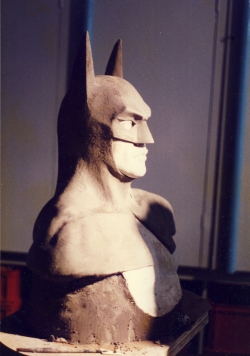
VB: That’s because you must have seen a really old suit, which had de-laminated. (The fine rubbery coating from the Lycra base). After the punishment those suits were put through, it did part company from the Lycra base. Maybe it reacted to sweat. It had a great surface finish, but the stretch wasn’t great, so I think we were probably asking more of it than it was designed to do. By the time we got to BATMAN RETURNS, there was more choice in high-tech fabrics to choose from.
(We had to make) 20 (complete suits) to cover backups and stunts. The capes were being manufactured at Pinewood in a huge polythene tent, where Paul Barratt Brown sprayed black latex onto a giant mold. Bob devised a brilliant fastening for that cape – it was a stroke of genius not only of how to take the weight, but how the points on the cowl melded into the cape.
PJW: This was a harness that was worn under the undersuit which had screws through the amour to attach the cape right?
VB: It was more of a corset, or we called it a corset, probably a “corselette” would have been more accurate – but we never called it that in front of Michael! It was boned but had a stretch back, and yes it was where the metal plates were attached on the chest, which accommodated the cape fastening plates, and then the emblem on top of that, which concealed the ironmongery. The emblem was fastened with the wonderfully low-tech “Black Tack.”
PJW: Didn’t you also insert metal plates in the sides of the cowl to stop the cheeks popping out?
VB: Yes that’s right, it was kind of primitive, but it worked. They were just simply cut-out pieces of aluminum sheet, glued in with 355 medical adhesives (legal in those days!), with a thin piece of kid leather over it, cut a little larger to cover the edges (which had been sanded smooth). So it was moldable to a certain extent.
The emblem and belt buckles were being machined in aluminum before being molded in silicone and cast in epoxy resin. The Bat boots were developed and made by Nike in the US.
Not only did we have our actor to dress as Batman, but we also had a stunt double, Batmobile driver, and an aerialist, all of whom were different sizes, and none of whom had been lifecast.
PJW: Speaking of the Batmobile, I understand the first time the canopy closed on it, it chopped off poor Batman’s ears. How was this problem overcome?
VB: It didn’t actually chop the ears off, but the left-hand ear (it was a left-hand drive car), was too tall for the slope at the side of the car. I seem to remember that the ear “gave” as it was latex foam (although with a semi-rigid core).
PJW: With so little time for testing it must have been quite daunting for everyone concerned when the suit was first worn?
VB: Our first fitting with a jetlagged Michael in London went with a bang. Standing in the Batsuit, and looking magnificent, we opened a bottle of champagne to celebrate and christen the costume. The cork shot out of the bottle, and hit a fluorescent tube right above Michael’s head, shattering it and sending sparks and shards of glass cascading all over our principal actor in his pristine new suit. I guess it broke the ice, and I think that must have been about the only time he was happy to have been wearing the cowl and heavy cape, which protected him from the glass!
The schedule had been incredibly tight. The first day of shooting at Pinewood found myself and costume maker Day Murch (To become official Bat Wrangler, before taking over my role when Joel Schumacher became director), still frantically finishing duplicate costumes before dressing Michael. Luckily, Michael left his contact lenses at the hotel, so a driver was sent for them, giving us a couple of precious hours to polish the suit with silicone spray, and get it camera-ready just seconds before the cameras rolled.
PJW: The Gotham City sets were incredible, can you describe what you thought when you first stepped foot on them?
VB: It was awe-inspiring to walk onto those sets. They had a tangible atmosphere and a slightly disturbing presence. Anton and Nigel Phelps created a whole other world. The Gotham streets and the town hall on the backlot were staggering. The perspective made the streets look far longer than they were, and it was a huge set. The architecture was so powerful and I remember the set dressing also being wonderfully detailed. I wished they had kept that set forever. It was tragic when it finally came down. Anton certainly deserved that Oscar! I was at school with Anton. He was older than me, and I only really knew him by sight, but his family lived near mine. When we were both living in LA during Batman Returns, we used to reminisce about our old school, Michael Hall, in Sussex. Anton’s death was nothing short of a tragedy, and a massive loss to his family, friends, and the film industry.
We had a lot of night shooting on Anton Furst’s magnificent set on the backlot at Pinewood. It was a bitter English winter and ice had formed on the puddles by morning. Far from being warm and cozy in his Batsuit, on the long cold night shoots, Michael was frozen. Rubber does not keep you warm when it’s cold, neither does it cool you down when it’s hot. We bundled him up with duvet coats between takes and plied him with hot drinks, but this experience far from made him an anglophile – he felt a long way from balmy Pacific Palisades on that film. He was a happy man when it was decided that BATMAN RETURNS would be shot on the Warner’s lot in LA – and we were all pretty happy about that too!
PJW: Did you have any interaction with any of the other cast members? Were you able to see any scenes being shot?
VB: Yes absolutely, particularly during scenes with both Batman and other characters. We shot many scenes with Batman and the Joker at Acton Power Station (my favorite line in the film when The Joker looks at Batman and says “Nice outfit” was shot there). It was quite a sociable film too, Tim gave parties, and Bob and I had a huge Thanksgiving party for the cast and crew at my studio. It was fancy dress, and the food was all American. The Stars and Stripes were projected on the wall at the end of the mews, and my piece de resistance was the cake. I had 2 vac forms taken off a fiberglass cast of the head, back, and front, and had it cast in chocolate and filled with praline. It was so heavy, that four people had to carry it in. It was gone in 5 minutes flat.
PJW: Was there ever a point during the making of the film where you thought “This is going to be something special.”?
VB: Not really, it was pretty much just another job at the time, and I think we were quite relieved when it was over. Of course, it was fantastic that it became such a huge success, and by the time the film came out, the freezing night shoots and struggles to get successful foams good enough to shoot on, were all in the past.
None of us knew that the film would become the huge overnight success it became, and resources were very limited. But with a fantastic team and the magic of cinema, it all worked out.
Looking back at the first Batman costume, it was great for its time and had set a new precedent for superhero costumes. The finish, however, was not what it became on BATMAN RETURNS and beyond. But I have fond memories and feel affection for that first-ever Batman costume – especially the first rough quick sculpt, now immortalized in plaster and gathering cobwebs in my barn.
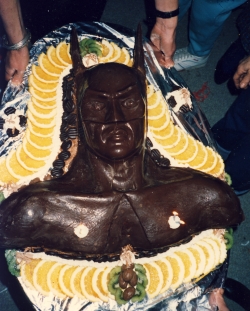
VB: Well it depends. If it was the same period of time, probably not, because it was early days in this type of costume making, it may even have been the first of this type of suit. But if I was to start again now, yes, of course, techniques and materials have moved on, out of all recognition now. But if I was turning the clock back, I would add another couple of months to our build time, then we could have made a fiberglass master and polished it. The finish of the first suit was very basic, literally from clay straight to foam, it should have had the same finish as the Batmobile. Still, we had the luxury of time and resources on BATMAN RETURNS, and were able to lavish the skills of our mold shop on making flawless masters before the final foam molds were made. Oh and another thing – that seam down the back of the head – painful to remember it! Again, on the sequel, Paul James made a collapsible core, which gave us a perfectly seamless head – and of course, nobody noticed it wasn’t there, because there was nothing there to notice.
I adored working with Bob and Tim and did both of Tim’s films, then I became a designer in my own right. I said a fond goodbye to my home at the Batshop, in Burbank never to return to Gotham City. As an homage to my time on Batman, I created a miniature costume called the “Bad Black Bat” as part of The Little Costume Shop www.thelittlecostumeshop.com/archive, where Batman and my first home, The Royal Ballet have come together.
I would love to acknowledge my fantastic team on BATMAN: Alli Eynon, Day Murch, Niki Lyons, William Todd Jones, Paul James, Toad, Janie Lashford, and Miranda Watkins. Phil Reynolds made the bodysuits, Ian Morse and Aaron Sherman ran the latex foam, The mold making was done by the plaster shop at Pinewood, Annie Crawford ran the costume department. onset, the boots were made by Nike, and the capes by Paul Barrett Brown. And at the helm of it all was Bob Ringwood with his right-hand man, Graham Churchyard.
Vin’s first book, BEST EVER KIDS COSTUMES was published by Collins & Brown in October 2009 and is available now in book shops and on Amazon.
She is currently writing her own book entitled COSTUME DRAMAS, about the world of costume, backstage, and off-camera.
Vin has recently launched THE LITTLE COSTUME SHOP, a collection of intricately detailed costume miniatures. Her latest collection is made exclusively for and is currently exhibited at the Royal Opera House, Covent Garden, until the end of the year. – Paul Wares



